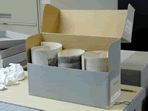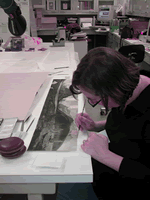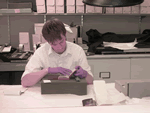
Conservation of the Panoramic Photographs
| The
Walcott panoramas are developed-out silver gelatin prints on paper.
Due to their extraordinary length (up to 8 ½ feet long),
the panoramas were stored rolled-up in boxes for an unknown length
of time, but probably for many decades. The storage conditions
made access to the images very difficult for researchers and dangerous
for the fragile documents, as the photographs’ fragile surfaces
were vulnerable to abrasion and cracking when pulled and unrolled
for examination. The panoramas were also heavily soiled from years
of airborne pollution.
To curate the exhibition, items were gently unrolled and examined for visual and documentary interest. Once selected, the items were rerolled and transferred to the Smithsonian Center for Archives Conservation laboratory at the Smithsonian Center for Materials Research and Education for treatment. A photograph conservator was hired to consult on the treatment protocol, and the treatments were performed by the Smithsonian Institution Archives (SIA) Preservation Team and the McMillan Conservator. Condition reports and treatment proposals were written, noting special requirements for each item, and approved by SIA. The prints were gently surface-cleaned of soil, with care to avoid disturbing the clarity of Walcott’s pencil and ink annotations and original carbon-copy labels (adhered to the back of most prints). After cleaning, the prints were carefully humidified in large tents until the prints were pliable but not wet. The relaxed prints were placed between layers of non-stick polyester web and absorbent blotters and dried under weight to flatten them. When the prints were fully dried, individual treatments were performed including flattening of creases, mending tears, and loss compensation (filling in and toning losses with compatible papers, toned to match with acrylics). When treatment was completed, the prints were elegantly framed by an established contractor. In addition to the prints, two of Walcott’s personal diaries, and a Cirkut camera from the Photographic History Collection, National Museum of American History, Behring Center selected for exhibition also required treatment. The diaries were treated by the McMillan Conservator and the camera was treated by the conservator at American History. |
||
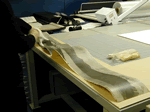 Conservator examining distortion of two prints |
||
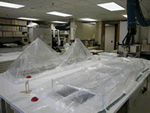 Prints in humidification tents |
